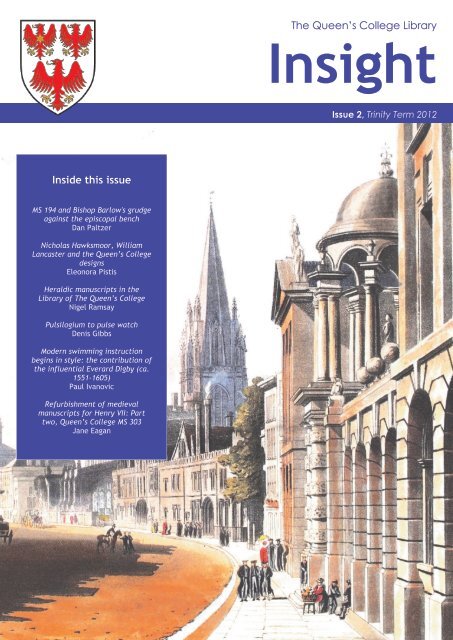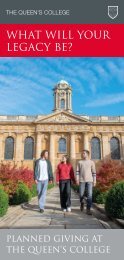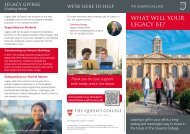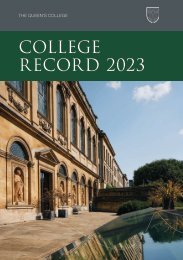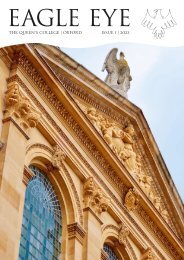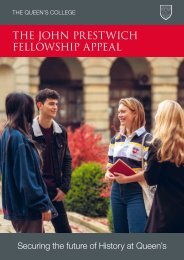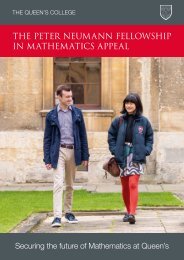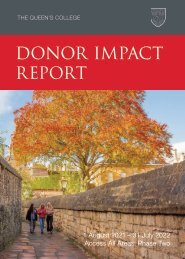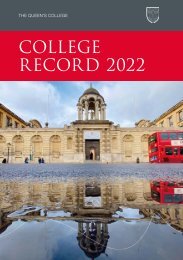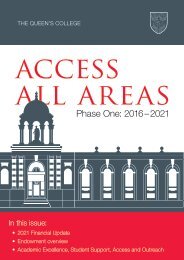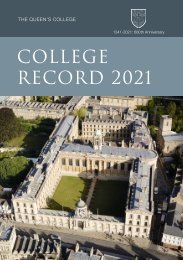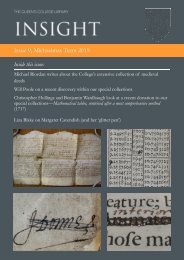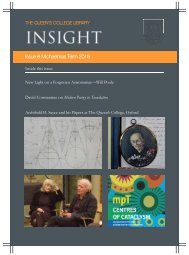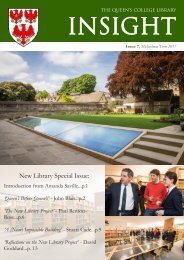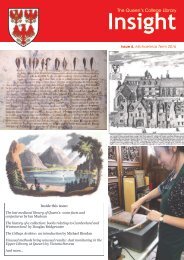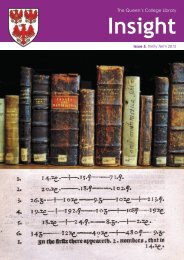Insight 2012
You also want an ePaper? Increase the reach of your titles
YUMPU automatically turns print PDFs into web optimized ePapers that Google loves.
The Queen’s College Library<br />
<strong>Insight</strong><br />
Issue 2, Trinity Term <strong>2012</strong><br />
Inside this issue<br />
MS 194 and Bishop Barlow's grudge<br />
against the episcopal bench<br />
Dan Paltzer<br />
Nicholas Hawksmoor, William<br />
Lancaster and the Queen’s College<br />
designs<br />
Eleonora Pistis<br />
Heraldic manuscripts in the<br />
Library of The Queen’s College<br />
Nigel Ramsay<br />
Pulsilogium to pulse watch<br />
Denis Gibbs<br />
Modern swimming instruction<br />
begins in style: the contribution of<br />
the influential Everard Digby (ca.<br />
1551-1605)<br />
Paul Ivanovic<br />
Refurbishment of medieval<br />
manuscripts for Henry VII: Part<br />
two, Queen’s College MS 303<br />
Jane Eagan
2<br />
W<br />
elcome to the second issue of<br />
<strong>Insight</strong>, the annual publication<br />
which seeks to highlight some of<br />
the treasures of the Queen’s<br />
Library, both to members of the College and to a<br />
wider audience at home and further afield.<br />
THE QUEEN'S COLLEGE LIBRARY NEWSLETTER<br />
In this issue we again have a variety of articles on<br />
printed book and manuscript collections in the<br />
Library, both from regular readers of the collections<br />
and from members of the Library team.<br />
These include an article on the Library’s large<br />
collection of heraldic manuscripts by Nigel<br />
Ramsay of University College London, and an<br />
account of Thomas Barlow’s grudge against the<br />
Episcopal bench by Dan Paltzer, who spent several<br />
weeks in the Library last summer researching<br />
Barlow for his PhD thesis. Denis Gibbs, who has<br />
been visiting the Library to consult our early<br />
medical collection since the 1960s, has written<br />
about Sir John Floyer, whose collection in the<br />
Library formed the basis of a successful cataloguing<br />
and conservation project funded by the<br />
Wellcome Trust some years ago. Paul Ivanovic,<br />
our rare books cataloguer, has contributed an<br />
article about his favourite printed book in the<br />
Library, Everard Digby’s De arte natandi, while<br />
Jane Eagan, our head conservator, has written the<br />
second in her series on the refurbishment of our<br />
Henrician medieval<br />
manuscripts.<br />
Fig. 1: Frontispiece<br />
depicting Charles II, from<br />
the first volume of Wood’s<br />
Historia et antiquitates<br />
Universitatis Oxoniensis ,<br />
recently bequeathed to the<br />
Library by old member Mr<br />
J. A. Colmer. The Sheldonian<br />
Theatre can be seen in<br />
the background. (Sel.b.281a)<br />
Over the last year we<br />
have received several<br />
visits from groups<br />
interested in our<br />
fascinating collection of<br />
original Hawksmoor<br />
propositions for the rebuilding<br />
of the College<br />
in the early eighteenth<br />
century, and I am<br />
particularly pleased to<br />
be able to include in<br />
this issue an article<br />
about Hawksmoor’s<br />
designs for Queen’s by<br />
Eleonora Pistis of<br />
Worcester College,<br />
Oxford.<br />
It is not often that we<br />
add to our historic<br />
collections but this year,<br />
as a result of the sad<br />
death of old member Mr<br />
Fig. 2: p. 125 and facing plate showing an illustration of<br />
Queen’s Chapel, from Ackermann’s A history of the<br />
University of Oxford, recently bequeathed to the Library by<br />
old member Mr J. A. Colmer. (Sel.c.200a)<br />
J. A. Colmer in late 2011, we received a bequest of<br />
23 early printed books. Many of the volumes are<br />
extremely rare including a copy of Anthony<br />
Wood’s 1674 Historia et antiquitates universitatis<br />
Oxoniensis bound in two volumes interleaved with<br />
Loggan’s 1675 Oxonia illustrate (fig. 1). Another<br />
wonderful addition to our collection of antiquarian<br />
material relating to Oxford is Ackermann’s 1814<br />
two volume History of the University of Oxford<br />
(fig. 2) containing exquisite prints of College and<br />
University buildings which, rather surprisingly, we<br />
did not have in the collection previously. One of<br />
the most interesting parts of the collection are the<br />
five volumes of East India tracts including a<br />
number of items not held by the British Library<br />
until Mr Colmer provided copies of some of them.<br />
The collection as a whole is an extremely welcome<br />
addition to the College Library and I am most<br />
grateful to Mr Colmer for remembering us in this<br />
particularly generous way.<br />
As last year I am most grateful to all the contributors<br />
to this issue of <strong>Insight</strong> and in particular to<br />
Lynette Dobson who has produced the Newsletter<br />
for us.<br />
If you have ideas for future articles or indeed<br />
would like to contribute, please contact me at<br />
amanda.saville@queens.ox.ac.uk<br />
Amanda Saville<br />
Librarian<br />
June <strong>2012</strong><br />
Cover image: Section of illustration of High<br />
Street, Oxford from Ackermann’s A history of the<br />
University of Oxford.
MS 194 and Bishop Barlow's grudge against the episcopal bench 3<br />
MS 194 and Bishop Barlow's grudge<br />
against the episcopal bench<br />
Dan Paltzer<br />
University of Minnesota<br />
W<br />
hen I came to the Library at<br />
Queen’s College last summer, I<br />
was searching for the answer to a<br />
deceptively simple question. Why<br />
would a seventeenth-century Anglican bishop<br />
write a pamphlet arguing that none of the bishops<br />
should be allowed to participate in the Earl of<br />
Danby’s impeachment before the House of Lords?<br />
Such a pamphlet contradicts everything which one<br />
would expect of a bishop from that day. Yet this<br />
was exactly the position that Thomas Barlow, the<br />
Bishop of Lincoln, took in his pamphlet A discourse<br />
of the peerage & jurisdiction of the lords<br />
spiritual in Parliament (1679). This pamphlet was<br />
Barlow’s intervention in an ongoing debate about<br />
whether the bishops could participate in the<br />
impeachment trial or attainder of Charles II’s chief<br />
minister. From the evidence he found in legal<br />
records, Barlow concluded that the bishops were<br />
legally banned from such proceedings.<br />
This was a very strange position for Barlow to<br />
take, and one which seemingly violated his usual<br />
political convictions as a staunch royalist. Danby<br />
was under attack by the Earl of Shaftesbury, who<br />
therefore wanted to prevent the bishops from<br />
voting to acquit Danby in this capital trial.<br />
Shaftesbury therefore unburied an old custom that<br />
had roots in canon law which prevented clergymen<br />
from judging “cases of blood”.<br />
Oddly enough, Barlow agreed with Shaftesbury<br />
and argued that the bishops should withdraw from<br />
all cases of blood. I find this position odd, because<br />
it contradicts the theological and political positions<br />
which Barlow defended in all of his other<br />
publications as well as most of the manuscript<br />
treatises he left in the Queen’s College Library.<br />
For the sake of comparison, consider De Jure<br />
Regio Monarchiae Anglicanae (MS 194), where<br />
Barlow proved himself to be a firm supporter of<br />
the divine right of kings. This short treatise was<br />
actually written to contradict Shaftesbury, even<br />
though a few years later he would take the Earl’s<br />
side on the issue of bishops during capital trials.<br />
This piece proclaimed an ideology which one<br />
would expect from an Anglican bishop. Shaftesbury<br />
had delivered a speech to the House of Lords<br />
on 20 Oct 1675 in which he claimed the doctrine of<br />
the divine right of kings was the most dangerous<br />
and destructive doctrine there had ever been to<br />
English government and law. Furthermore, it was<br />
a relatively new error introduced by the Laudian<br />
clergy. Barlow dismissed this idea on three<br />
counts. Divine right was neither new, nor dangerous,<br />
nor destructive. The doctrine had a strong<br />
basis in Scripture, and had even been revealed to<br />
pagans through the use of natural reason. Therefore,<br />
the King of England (and, by implication, all<br />
other legitimate monarchs) held his crown by the<br />
will of God, and not from the Pope, the people, or<br />
laws of England.<br />
The dilemma which brought me to Queen’s was<br />
how to explain the position in the pamphlet<br />
concerning bishops and cases of blood, because<br />
this publication supported the political machinations<br />
of a man whose ideology Barlow generally<br />
opposed. In the manuscript described above, as<br />
well as his other publications from the 1670s and<br />
early 1680s, Barlow consistently supported the<br />
political positions associated with the Tory side of<br />
the Popish Plot and Exclusion Crisis. He remained<br />
a steadfast proponent of the established,<br />
episcopal Church of England and a firm supporter<br />
of the Stuart dynasty until just before the Glorious<br />
Revolution. So what would cause a bishop to<br />
argue a position which would effectively weaken<br />
the political position of bishops by removing them<br />
from important matters which came before the<br />
House of Lords?<br />
As it turns out, Barlow’s position was conditioned<br />
by ongoing disagreements between himself and<br />
the rest of the episcopal bench. In The state of the<br />
controversy between the Rt. Revd John Ld Bishop<br />
of Oxon and ye Bishop of Lincolne about ordination<br />
in Q. Coll. Chappell. 1676 (MS 194 - fig. 1<br />
overleaf), Barlow described his side of an argument<br />
between himself and John Fell, the aforementioned<br />
Bishop of Oxford. The conflict Barlow<br />
described was simultaneously based on his<br />
personal preference to remain in the congenial<br />
habitations at Queen’s College and his ideological<br />
commitment to maintaining Oxford University<br />
and its constituent colleges’ rights to autonomy.<br />
Barlow’s account of the spat focused primarily on<br />
the legality of his actions under English law, with<br />
occasional claims that he did not act against<br />
Christian doctrine and insults for his opponent<br />
thrown in for good measure. The difficulties
4<br />
THE QUEEN'S COLLEGE LIBRARY NEWSLETTER<br />
outside of them but still within English society,<br />
such as Presbyterians or leaders of the political<br />
opposition to the Crown (such as Shaftesbury in<br />
the example above). The task of writing this<br />
defence against Fell combined both institutional<br />
allegiances and personal preference, and it<br />
therefore contrasted with the way he wrote in<br />
other pamphlets or treatises.<br />
Fig. 1: Title page for Barlow’s letter The state of the controversy<br />
between the Rt. Revd John Ld Bishop of Oxon and ye Bishop of<br />
Lincolne about ordination in Q. Coll. Chappell. 1676. (MS 194)<br />
began when Fell sent Barlow a letter mere hours<br />
before Barlow was scheduled to begin ordaining<br />
new clergymen for his diocese in the chapel of<br />
Queen’s College. The letter asked Barlow not to<br />
proceed with the ordination, but Barlow saw no<br />
reason why he could not go ahead with the<br />
ceremony. After the ordination, Barlow sent Fell a<br />
letter explaining why these affairs were none of the<br />
Bishop of Oxford’s business. The University of<br />
Oxford, and all of its constituent colleges, had<br />
never really been under the episcopal authority of<br />
the local diocese. Ironically enough, until Henry<br />
VIII created a new bishopric in Oxford, the town<br />
was part of the diocese of Lincoln, which was<br />
Barlow’s see. However, Barlow claimed the<br />
Bishops of Lincoln had never been allowed to<br />
exercise authority over the University of Oxford.<br />
The Provosts of the University and visitors of<br />
particular colleges administered colleges’ spiritual<br />
and administrative affairs without interference<br />
from the Bishops of Lincoln. The 1541 charter<br />
which created the new bishopric in Oxford<br />
expressly preserved these rights and privileges.<br />
Fell had no jurisdiction over Queen’s College.<br />
Barlow had received permission from the proper<br />
authorities at Queen’s, therefore he felt he had<br />
acted within the bounds of clerical and legal<br />
propriety.<br />
The wonderful thing about MS 194 is that it<br />
humanizes an otherwise abstract vision of ideological<br />
allegiances in seventeenth-century England.<br />
In broad terms, Barlow’s ideological positions<br />
on matters such as divine right monarchy or<br />
bishops’ spiritual powers reflected the official<br />
policies of the Anglican Church. He defended<br />
these institutions from opponents who were<br />
MS 194 reveals a different kind of conflict, because<br />
it was between different factions of institutional<br />
insiders. Barlow’s conflict with the other bishops<br />
stemmed from his refusal to leave Queen’s College<br />
and take up residence at Lincoln. This was a man<br />
who loved life at Queen’s College (and if the people<br />
at Queen’s in his day were half as friendly and<br />
helpful as the current library staff of Amanda,<br />
Lynette, Rory, and Tessa, I can’t really blame him<br />
for not wanting to go). Due to this affection,<br />
Barlow wanted to preserve the administrative<br />
autonomy of the Oxford University colleges (and<br />
Queen’s in particular), because this autonomy<br />
allowed his college to continue to function in its<br />
traditional modes. Legal documents such as<br />
Parliamentary statutes and royal charters were the<br />
instruments establishing and protecting that<br />
autonomy, so Barlow fiercely defends the entire<br />
system which perpetuated these protections.<br />
In practical terms, this defence required him to<br />
protect the integrity of the common law from any<br />
outsiders (including the other bishops) who might<br />
try to interfere in college business. In order to<br />
make sure he could keep out anyone who wanted<br />
to intrude where he thought they did not belong,<br />
Barlow needed to ensure the integrity of the<br />
institutional elements responsible for protecting<br />
and enforcing English law. The House of Lords<br />
was one of these elements, insofar as certain types<br />
of cases were heard before that body. In all of his<br />
publications, Barlow wished to maintain a particular<br />
ideological understanding of how elements<br />
within English society relied upon each other and<br />
ought not to overstep their bounds to transgress<br />
upon other institutions’ traditional functions.<br />
However, MS 194 showed that he had personal<br />
reasons for this as well. The conflict between<br />
himself and the other bishops made him suspicious<br />
that the other prelates were willing to<br />
overstep such boundaries, which in turn explains<br />
why he could oppose Shaftesbury’s policies<br />
generally while also writing a pamphlet intended<br />
to show that bishops should not judge Danby’s<br />
trial.
Nicholas Hawksmoor, William Lancaster and the Queen’s College designs 5<br />
Dan Paltzer is a PhD candidate of the Department<br />
of History at the University of Minnesota-Twin<br />
Cities. Prior to arriving at Minnesota, he was a<br />
Government major at Lawrence University in<br />
Appleton, WI (BA) and a graduate student in the<br />
Department of Political Science at Vanderbilt<br />
University (MA) where he studied Political<br />
Theory. His political theory background led him<br />
into an interest in early modern political thought<br />
and its place within broader intellectual trends of<br />
the time period running roughly from 1500-<br />
1800. His dissertation research involves the<br />
ways in which English pamphleteers interpreted<br />
history through ideological lenses during the<br />
1680's.<br />
Nicholas Hawksmoor, William Lancaster<br />
and the Queen’s College designs<br />
Eleonora Pistis<br />
Worcester College, Oxford<br />
O<br />
n 6th February 1710, coincident with<br />
Queen Anne’s birthday, the Vice-<br />
Chancellor of Oxford University<br />
William Lancaster (1650–1717) laid the<br />
foundation stone for a new Queen’s College, of<br />
which he had been Provost since 1704 (fig. 1). 1 In<br />
1714, John Ayliffe wrote that, when finished, the<br />
new building would be ‘one of the most Majestick<br />
Pieces of Architecture in the whole Kingdom.’ 2<br />
During Lancaster’s Vice-Chancellorship (1706–<br />
1710) – and most likely between 1708 and 1709 4 –<br />
another figure drew up different preliminary<br />
designs: the architect Nicholas Hawksmoor (1661–<br />
1736). Hawkmoor’s contribution amounts to<br />
twenty drawings, still kept in Queen’s Library,<br />
representing seven different projects which the<br />
architect entitled Propositions. 5<br />
Fig. 1: William Lancaster<br />
(1650-1717)<br />
As has already been pointed out, the final design<br />
of Queen’s College’s cannot be regarded as the<br />
work of a single mind. 3 It is usually ascribed to the<br />
amateur architect Dr. George Clarke, with the<br />
assistance of the master mason William Townesend.<br />
The majority of these<br />
designs have already<br />
been published and<br />
discussed in the<br />
scholarly literature. 6<br />
Within what Colvin<br />
c a l l e d ‘ U n b u i l t<br />
Oxford,’ Hawksmoor’s<br />
propositions are<br />
usually regarded as<br />
the ‘fiasco’ 7 of an<br />
‘expensive architect<br />
with a penchant for<br />
adding extravagant<br />
and functionally<br />
unnecessary gestures.’<br />
8 But was there a<br />
r e a s o n b e h i n d<br />
Hawksmoor’s ‘extravagant’ solutions? Should his<br />
designs be considered a failure? The aim of this<br />
brief contribution is to analyse Hawksmoor’s<br />
designs in the context of his relationship with his<br />
patron, in order to identify his main aims and<br />
reevaluate his achievements.<br />
The designs for Queen’s mark the beginning of the<br />
history which bound Hawksmoor to the city of<br />
Oxford for nearly three decades (ca. 1708–1736).<br />
They are addressed to William Lancaster, at that<br />
time the most powerful figure within the University<br />
and a man with an interest in architecture –<br />
potentially a perfect patron. Lancaster’s interest in<br />
architecture is confirmed by the presence of his<br />
name in a plate from the Vitruvius Britannicus<br />
(1715) which illustrates a design by Colen Campbell<br />
for a church on Lincoln’s-Inn Fields, dated<br />
1712 9 ; while his involvement in Oxford’s architectural<br />
activities is confirmed by Thomas Hearne,<br />
who, in reference to William Townesend, wrote:<br />
‘a great many justly wonder that he should have<br />
been so much made use of by the University. But<br />
this, I believe, is owing in good measure to Dr.<br />
George Clarke of All Souls, as it was also to Dr.<br />
Lancaster of Queen’s.’ 10<br />
Certain aspects of Hawksmoor’s drawings for<br />
Queen’s College confirm that the architect must<br />
have been aware of Lancaster’s potential as<br />
architectural patron. Various annotations demonstrate<br />
that this set of drawings was conceived as an<br />
introductory portfolio addressed not simply to the<br />
Provost of the College, but to the Vice-Chancellor.<br />
With a great deal of insistence, in fact, in more<br />
than one drawing Hawskmoor craftily indicates<br />
the ‘Vice Chancellor’s lodgings’. 11
6<br />
THE QUEEN'S COLLEGE LIBRARY NEWSLETTER<br />
The Queen’s designs can be distinguished within<br />
the whole corpus of Hawksmoor’s designs for<br />
Oxford 12 based on three main characteristics. The<br />
first is the exceptionally large size of the sheets,<br />
which measure up to 0.52 by 1.385 metres. The<br />
second is the accuracy of the drawings. Although it<br />
is true that some are unfinished and several are by<br />
an assistant, 13 the propositions which Hawksmoor<br />
labeled ‘A’ and ‘IV’ are particularly well-defined.<br />
The third, as we will see, is the propositions’<br />
provocative character relative to the Oxford<br />
architectural tradition, in terms of both typology<br />
and language.<br />
If the first two characteristics are compatible with<br />
the intention of receiving the Queen’s’ commission,<br />
the third reveals a broader and slightly<br />
different purpose. In the absence of any precise<br />
indications dictated by the prospective client, 14<br />
Hawksmoor demonstrated his ability to elaborate<br />
infinite typological solutions in plan and volume,<br />
using a language composed of an extraordinary<br />
wide range of sources. Hawksmoor’s main aim<br />
seems to have been to present himself to Lancaster<br />
as the right architect not only for Queen’s, but<br />
potentially for any building, with skills that would<br />
have distinguished himself from amateurs or<br />
master masons.<br />
Hawksmoor’s propositions reveal the architect’s<br />
strategy in front of his new client. Queen’s presented<br />
Hawksmoor with his first opportunity to<br />
consider how to shape a college from scratch, a<br />
subject to which he would return many times in<br />
the next twenty-five years. He began by organizing<br />
the college around two regular quadrangles, as in<br />
Clarke’s contemporary masterplan for All Souls,<br />
with a symmetry and regularity that was completely<br />
new to Oxford. There was, however, one<br />
crucial difference: at Queen’s College, the Old<br />
Library and the newly built north range were<br />
already existing elements which Hawksmoor was<br />
obliged to incorporate into his project. 15 This is the<br />
reason why, in all of the propositions, the second<br />
quadrangle is always less prominent, while in<br />
Clarke’s masterplan for All Souls it is the most<br />
important element. 16 With a radically different<br />
approach, Hawksmoor focused on the definition of<br />
the first quadrangle, which in PROPOSITION V,<br />
QUEEN’S 14 and 15 (fig. 2, top left), he expanded to<br />
occupy all of the available area. In designing the<br />
entrance of the latter, he employed an erudite<br />
quotation: the vestibule of the Palazzo Farnese in<br />
Rome.<br />
Fig. 2: Plan drawings of Hawksmoor’s propositions. Left to<br />
right, top to bottom: Queen’s 15 ; Proposition III ; Queen’s<br />
17 ; Proposition II ; Proposition A ; Proposition IV.<br />
With the balance between the two quadrangles<br />
abolished, Hawksmoor next concentrated on the<br />
two vital nuclei of any college, the hall and chapel.<br />
These became the crux of the project. In PROPOSI-<br />
TION I, the hall and chapel are along the High<br />
Street, whereas in almost all of the other proposals<br />
the hall and chapel, or the chapel alone, are<br />
instead positioned in the range that separates the<br />
two quadrangles.<br />
The central position of the hall and chapel,<br />
provided an opportunity for Hawksmoor to design<br />
various innovative solutions that transformed the<br />
transversal range into a complex organism, one<br />
that is moulded and expands to the point that in<br />
PROPOSITION III (fig. 2, top centre) it occupies<br />
much of the second quadrangle. Here the hall and<br />
chapel are connected by a semicircular colonnade,<br />
with a couple of twin columns positioned in a<br />
radial perspective, interrupted by a telescopic<br />
passageway that frames a peripteral temple<br />
against the north range. It is a solution reminiscent<br />
of the screen of columns present in a preliminary<br />
design for Greenwich. The most direct<br />
source, however, is Bernini’s St Peter’s Square,<br />
depictions of which abounded in the libraries of<br />
Oxford of the time.<br />
In other proposals the chapel is detached or semidetached<br />
at the centre of a large court. In PROPOSI-<br />
TION VI and its variation QUEEN’S 17 (fig. 2, top<br />
right) it has an oval structure, which perhaps<br />
alludes to Bernini’s third design for the Louvre,<br />
which would have been familiar to Hawksmoor
Nicholas Hawksmoor, William Lancaster and the Queen’s College designs 7<br />
Fig. 3: Proposition IV, High Street elevation.<br />
from the engravings in the Grand Marot and<br />
probably from the enthusiastic descriptions by<br />
Christopher Wren, who appreciated models of the<br />
scheme when he visited Paris in 1665. In PROPOSI-<br />
TION II (fig. 2, bottom left), as in QUEEN’S 14, the<br />
chapel becomes a peripteral temple.<br />
Fig. 4: Proposition IV, front quadrangle, east-west section<br />
showing the north side elevation.<br />
By using a court layout with a church at the centre<br />
of the rear range, as in PROPOSITION A (fig. 2,<br />
bottom centre) Hawksmoor seems to refer in part<br />
to Solomon’s Temple, as designed by Villalpando<br />
and reinterpreted in the Escorial and later also in<br />
the Hôtel des Invalides. 17 But this later reference is<br />
only a part of a wider focus on French sources,<br />
well known thanks to George Clarke’s print<br />
collections. 18 Hawksmoor not only seems to refer<br />
to Louis Le Vau’s designs for the Louvre<br />
(PROPOSITION A), but in QUEEN’S 17 he also<br />
designed the first quadrangle with a concave side<br />
after the model of countless Parisian Hôtels. He<br />
also adopted the structure of the rusticated<br />
gateway from the Palais du Luxembourg – see<br />
PROPOSITION VI.<br />
As Downes pointed out, PROPOSITIONS A and IV<br />
are the only ones to have been developed entirely<br />
and coherently. As we have seen, they are the most<br />
accurate and contain references to the Vice-<br />
Chancellor Lancaster.<br />
PROPOSITION IV (fig. 2, bottom right) is illustrated<br />
in five drawings. The gateway at the centre of the<br />
monumental High Street front is framed in a<br />
stunning and out-of-scale manner by two huge<br />
composed Doric columns, sixty feet tall (fig. 3).<br />
This astonishing entrance evokes the Gothic access<br />
towers of medieval cloisters, but interprets its<br />
vertical development in terms of archaic monumentality,<br />
as that of the Pillars of Hercules. Going<br />
through the High Street entrance, one would<br />
Fig. 5: Proposition A, High Street elevation.<br />
arrive in the first quadrangle. The hall and the<br />
chapel are en pendant in the north range and<br />
divided by a vestibule (fig. 2-4). 19 The lateral sides<br />
of the façade clearly evoke the lateral facades of<br />
the court of the Curia Innocenziana in Rome,<br />
whereas the fenestration, with large headed<br />
windows set within deep concave recesses, recalls<br />
the niches of the drum of St Paul’s. The façade of<br />
the central vestibule is a tetrastyle pronaos that, as<br />
in the Basilica Aemilia, ends in a terminal column<br />
flanked by a pilaster, a device that had been<br />
employed already in one of the preliminary<br />
projects for Greenwich Hospital and later at<br />
Blenheim. Onto the quadrangular vestibule is<br />
grafted a low octagonal drum flanked by cinerary<br />
urns superimposed on sacrificial altars. On this<br />
low drum is a second one, higher and articulated<br />
by paired columns and by hefty buttresses that<br />
frame wide openings: the model is Michelangelo’s<br />
drum at St Peter’s in the Vatican, mediated by the<br />
combination of pronaos and attic of the Sant’Agnese<br />
in Rome, whereas the buttresses are modelled<br />
on Borromini’s Sant’Ivo. This powerful<br />
structural system surprisingly supports a lowtiered<br />
dome with steps based on the model of the<br />
Pantheon.<br />
PROPOSITION A (fig. 2, bottom centre), illustrated<br />
in four large designs, is based on the other projects:<br />
from PROPOSITION I it takes the position of
8<br />
THE QUEEN'S COLLEGE LIBRARY NEWSLETTER<br />
Fig. 7: Proposition A, front quadrangle, north-south section<br />
showing the west side elevation.<br />
Fig. 6: Proposition A, front quadrangle, east-west section<br />
showing the north side elevation.<br />
the hall along the High Street; from PROPOSITION<br />
IV, at least in part, it takes the layout of the east<br />
and west ranges; from PROPOSITIONS VI it takes<br />
the idea of a central chapel with an interior dome,<br />
from PROPOSITION V the arrangement of the<br />
Chapel. The façade of the college along High Street<br />
is characterized by a rusticated arcade surmounted<br />
by a main floor with giant Corinthian pilasters and<br />
by an attic floor (fig. 5). The central section of the<br />
façade is marked by a three bay recess, which<br />
forms a sort of triumphal arch, as in Le Vau’s<br />
design for the east façade of the Louvre (1664) .<br />
But here the central arch overruns the main floor<br />
and becomes a podium with French ornamentation<br />
that bears a female figure, perhaps Queen<br />
Anne. Going through the entrance vestibule, one<br />
would enter the first quadrangle. The north range<br />
(fig. 6) is dominated by the chapel orientated west<br />
-east, the south façade of which is a hexastyle<br />
pronaos of the Corinthian order two bays deep, a<br />
solution that Hawksmoor would use again in St.<br />
George’s in Bloomsbury (1713–1715). The pronaos<br />
is flanked on both sides by a single-storey rusticated<br />
arcade that leads to two symmetrical<br />
staircases, which give access to two lofty towers.<br />
These elements, with screens of columns and<br />
broken-based pediments, are characterised by<br />
ancient-style features reminiscent of Roman<br />
baths, probably mediated through Palladio. 20 The<br />
two side facades are composed of rusticated<br />
arcades, a main floor and attic (fig. 7). The ground<br />
-floor arcade is taken from the courtyard of<br />
Palazzo Thiene in Vicenza as illustrated in Palladio’s<br />
Four Books. 21 The monumental first floor is<br />
organised by raised bands, that evoke a trabeated<br />
system and frame double-level fenestration. The<br />
centre of the façade is marked with a curvilinear<br />
pediment free of any decoration.<br />
In sum, Hawksmoor drew up at least seven<br />
different innovative proposals for a new Queen’s<br />
College. By disrupting the traditional quadrangle<br />
structure, he concentrated on the hierarchic<br />
coordination between the various parts, orchestrating<br />
high and low elements and creating visual<br />
axes and sudden vistas. He employed a vast<br />
repertoire of architectonic sources taken from<br />
English tradition, but most of all from France and<br />
from ancient and modern Rome. Evocations of the<br />
Pantheon, St Peter’s, Hellenistic and Imperial<br />
architecture are combined together with references<br />
to Michelangelo, Palladio, Salomon de<br />
Brosse, Jones, Webb, Bernini, Borromini, Le Vau,<br />
Carlo Fontana, Hardouin-Mansart, Wren, and<br />
Vanburgh.<br />
Hawksmoor put on show his power of elaborating<br />
almost infinite architectonic solutions, suggesting,<br />
at the same time, the impossibility of an a priori<br />
selection without further indications from the<br />
prospective client. Every final decision, in fact,<br />
would have involved deep reflection on the<br />
ultimate purposes of the building, and this was<br />
evidently the task of Lancaster and his Fellows.<br />
The design that was finally approved demonstrates<br />
the reception of Hawksmoor’s suggestions. 22 The<br />
position of chapel and hall are connected by a<br />
Fig. 8: Queen’s today, front quadrangle, east side elevation.
Nicholas Hawksmoor, William Lancaster and the Queen’s College designs 9<br />
pronaos, as suggested in PROPOSITION IV; 23 and<br />
the layout of the lateral facades reflects PROPOSI-<br />
TION A, published here for the first time 24 . Within<br />
the old Oxford tradition, can this result be considered<br />
a complete ‘fiasco’?<br />
Soon after creating the Queen’s ‘Propositions,’<br />
Hawksmoor was employed for the Clarendon<br />
Building project by the same William Lancaster<br />
and his colleagues, the Delegates of the Press. 25<br />
From that moment on, he played a central role in<br />
planning an urban and architectural renewal of<br />
Oxford that would have changed the face of the<br />
city forever. 26 With the Queen’s designs,<br />
Hawksmoor had wanted to make himself known to<br />
the man who had more power than anyone else in<br />
Oxford to involve him in new projects. In the end,<br />
the architect accomplished this goal.<br />
Acknowledgements<br />
I would like to thank Amanda Saville for her kind<br />
suggestion to write this brief contribution on<br />
Hawksmoor’s Queen’s Designs. She and her staff<br />
have given much valuable help for my research on<br />
Oxford University architecture and its patronage<br />
between 1702 and 1736.<br />
1<br />
This initiative continued the late-seventeenth-century<br />
enlargement of the medieval college, which had included the<br />
creation of the Williamson Building on the northeast side<br />
(1671–1672) and the Library on the northwest side (1692–<br />
1696); followed in 1707 by a north range of which ‘one half of<br />
it’ was ‘at the sole charge of Dr Lancaster […] and the other<br />
half at the common expense of the Society’. Thus, the new<br />
building campaign of 1710 concerned the reconstruction of<br />
the remaing southern parts of College, which would have<br />
faced on High Street. See J. Magrath, The Queen’s College, 2<br />
vols. (Oxford, 1921), II, pp. 63-87; Victoria History of the<br />
County of Oxford, 16 vols., III, The University of Oxford<br />
(London, 1954), pp. 138-142.<br />
2<br />
J. Ayliffe, The ancient and present state of the University of<br />
Oxford (London, 1714), p. 301.<br />
3<br />
See H. Colvin, Unbuilt Oxford (New Haven and London,<br />
1983), p. 47; Nicholas Hawksmoor and the replanning of<br />
Oxford, ed. by R. White (Oxford and London, 1997).<br />
4<br />
K. Downes, Hawksmoor (London [1959] 1979), p. 102.<br />
5<br />
Six are numbered with roman numerals I-VI, and one<br />
labelled with the letter ‘A’. There are also three plans for<br />
alternative designs [Queen’s 14, 15, 17] and two High Street<br />
front elevations [Queen’s 18-20]. In Queen’s Library there is<br />
a manuscript catalogue by Roger White.<br />
6<br />
K. Downes, Hawksmoor, cit., pp. 102-107; H. Colvin,<br />
Unbuilt…, cit., pp. 47-53; G. Worsley, ‘Nicholas Hawksmoor:<br />
A Pioneer Neo-Palladian?’, Architectural History, vol. 33<br />
(1990), pp. 60-74; R. White, Nicholas Hawksmoor…, cit.,<br />
pp. 15-24.<br />
7<br />
K. Downes, Hawksmoor, cit., p. 107.<br />
8<br />
R. White, Nicholas Hawksmoor…, cit., p. 16; see also H.<br />
Colvin, Unbuilt…, cit., p. 47.<br />
9<br />
C. Campbell, Vitruvius Britannicus… (London, 1715), pl. 3.<br />
The plate is inscribed to William Lancaster ‘Vicar of St<br />
Martin in the Field [...] Provost of Queens College Oxon’.<br />
10<br />
Remarks and collections of Thomas Hearne, ed. by C. E.<br />
Doble, 11 vols. (Oxford 1885-1921), VII, p. 247.<br />
11<br />
See: Queen’s 3, 4, 12.<br />
12<br />
This corpus includes designs for All Souls College,<br />
Clarendon Building, Radcliffe Library, Brasenose, Worcester,<br />
Magdalen College.<br />
13<br />
K. Downes, Hawksmoor, cit., p. 102.<br />
14<br />
As already pointed out by Kerry Downes, Hawskmoor<br />
appears not to have had either an exact survey of the site or a<br />
master plan to follow as he had, for example, in the case of<br />
the later design for the Clarendon building.<br />
15<br />
See footnote 1.<br />
16<br />
For Clarke’s All Souls master plan see H. Colvin, Unbuilt…,<br />
cit., p. 36.<br />
17<br />
V. Hart, Nicholas Hawksmoor: rebuilding ancient<br />
wonders (New Haven and London, 2002), pp. 202-213, in<br />
particular p. 204.<br />
18<br />
T. Clayton, ‘The Print Collection of George Clarke at<br />
Worcester College Oxford’, Print Quarterly, 9 (1992), pp.<br />
123-141. During the Opler Conference at Worcester College<br />
(29th-31st March <strong>2012</strong>) I gave a paper on Clarke’s library<br />
entitled: Architecture and Oxford University in the early<br />
Eighteenth Century: George Clarke’s ‘Accademia’ and his<br />
library-laboratory.<br />
19<br />
For the arrangement of hall and chapel en pendant see K.<br />
Downes, Hawksmoor, cit., p. 104.<br />
20<br />
For Hawksmoor’s Palladian sources, see G. Worsley,<br />
‘Nicholas Hawksmoor…, cit. .<br />
21<br />
See footnote 20.<br />
22<br />
See G. Worsley, ‘Nicholas Hawksmoor…’, cit., p. 61; R.<br />
White, Nicholas Hawksmoor…, cit., p. 15.<br />
23<br />
See footnote 19.<br />
24<br />
The only part of the College that can be regarded as<br />
Hawksmoor’s work is the main gateway on High Street, built<br />
by W. Townesend in 1733-36.<br />
25<br />
K. Downes, Hawksmoor, cit., pp. 107-109; H. Colvin,<br />
Unbuilt…, cit., pp. 60-64; R. White, Nicholas Hawksmoor…,<br />
cit., pp. 45-48; G. Tyack, ‘The Clarendon Building: Printing<br />
House and Propylaeum’, Bodleian Library Record, 23<br />
(2010), pp. 41-63.<br />
26<br />
Hawksmoor and the Oxford renovatio urbis is the central<br />
subject of my PhD thesis ‘The Seat of the Muses’. Nicholas<br />
Hawksmoor and Oxford (University IUAV of Venice, 2011)<br />
and of my current book-project.<br />
Dr. Eleonora Pistis is Scott Opler Research Fellow<br />
in Architectural History at Worcester College,<br />
Oxford. She has conducted various studies on<br />
eighteenth-century European architecture, with<br />
particular attention to Italy, France and England.<br />
Her current book-project concerns Nicholas<br />
Hawksmoor, George Clarke and the renovatio<br />
urbis of Oxford.
10<br />
THE QUEEN'S COLLEGE LIBRARY NEWSLETTER<br />
Heraldic manuscripts in the Library of<br />
The Queen’s College<br />
Nigel Ramsay<br />
University College London<br />
M<br />
any hundreds of heraldic manuscripts<br />
of the Tudor and Stuart<br />
periods are extant today. Most are<br />
without much scholarly value as<br />
texts, being copies that were produced for sale to<br />
the numerous Englishmen who wished simply to<br />
be better informed about the heraldry and family<br />
relationships of their fellow countrymen. They<br />
were valued as reference books, rather like a<br />
Who’s Who today; and they were not the sort of<br />
book that anyone would have expected to find in<br />
an Oxford or Cambridge college library. Heraldic<br />
manuscripts began to enter the colleges’ collections<br />
only in the late seventeenth century, when<br />
the study of English history was itself starting to<br />
be seen as a suitable subject for study by the<br />
colleges’ Fellows.<br />
Original heraldic compilations are much rarer,<br />
and in principle those that were produced in the<br />
course of their official duties by the officers of<br />
arms (the three Kings of Arms, six Heralds of<br />
Arms and four Pursuivants of Arms who together<br />
comprise the College of Arms) became the property<br />
of their College. Almost all the original<br />
records of the visitations of the different counties<br />
of England and Wales that were carried out<br />
between the early sixteenth and late seventeenth<br />
centuries are today at the College of Arms; the<br />
most authoritative list of visitations and their<br />
records is accordingly that of Sir Anthony Wagner,<br />
in his Records and collections of the College of<br />
Arms (London, 1952). When heralds produced<br />
other books, for use in the course of their professional<br />
duties, there was a tendency for these<br />
compilations to be passed on, by gift or sale, to<br />
other officers of arms: open sales in the secondhand<br />
market must have been much less common<br />
than private-treaty sales by, say, heralds’ widows<br />
to practising heralds. There was a professional<br />
wish to keep the heralds’ books out of the hands of<br />
the herald-painters and other interlopers who<br />
posed a commercial threat to the heralds’ own<br />
private practices.<br />
Fig. 1: Drawing by Robert Glover of sealed attached to grant<br />
of the manor of Pesenhall to Roger Bigod, earl of Norfolk, by<br />
Alexander, King of Scotland. (MS 166, folio 2 recto)<br />
The most capable heralds have always tended to<br />
be both writers and compilers themselves as well<br />
as collectors of the works of their predecessors.<br />
Robert Glover, Somerset Herald, who died aged 44<br />
in 1588, was regarded in his own day as the most<br />
scholarly and capable of all the officers of arms;<br />
and he certainly was also the most prolific writer<br />
and transcriber of his age, as well as being a major<br />
collector of medieval and Tudor historical and<br />
heraldic manuscripts.<br />
The College of Arms was in a state of some<br />
disarray in the 1580s, and Glover’s enormous<br />
collection was divided and dispersed within a few<br />
months of his death. A good many of his manuscripts<br />
ultimately passed into the collections of<br />
other heralds—including his nephew John Philipot<br />
(these manuscripts later being acquired by the<br />
College of Arms) and Elias Ashmole (by whom<br />
they were bequeathed to the University of Oxford).<br />
A few were acquired by his near-contemporary<br />
Ralph Brooke (c. 1553-1625), Rouge Croix Pursuivant<br />
from 1580 and York Herald from 1592.<br />
Brooke was an acrimonious and litigious man,<br />
who frequently quarrelled with his fellow-officers<br />
of arms, but he was undoubtedly very capable; and<br />
his abilities extended to his collecting. He acquired<br />
a considerable group of manuscripts that had been<br />
written by Glover, and several of these are today at<br />
Queen’s.<br />
For the medieval historian, the most remarkable<br />
of these manuscripts of Glover’s is MS 166 (fig. 1).<br />
It is one of his books of miscellaneous notes, and<br />
was compiled in the mid to late 1570s. It is replete<br />
with excerpts and transcripts of medieval charters,
Heraldic manuscripts in the Library of The Queen’s College 11<br />
perhaps no more than a decade or two previously;<br />
it was also an opportunity for him to engage in<br />
original research, examining charters that might<br />
provide new material for some of his wider aims,<br />
such as his projected record of all the baronial<br />
families that there had ever been in England.<br />
Fig. 2: Williamson family tree and pasted in coat of arms of<br />
Joseph Williamson from Glover’s Visitation of Northamptonshire.<br />
(MS 112, folio 50 recto)<br />
interspersed with notes of heraldry seen in parish<br />
churches (in Essex, especially), draft funeral<br />
certificates (such as were written by heralds when<br />
they conducted public funerals that incorporated a<br />
display of the deceased’s coat of arms) and<br />
excerpts from medieval texts, such as the names of<br />
benefactors listed in the Almoner’s book of St<br />
Alban’s Abbey. As always with such collections of<br />
notes and transcripts, the direct historical value<br />
lies partly in the presence of copies of documents<br />
that in their original form have since been lost—<br />
although discovering whether the originals may<br />
survive is rarely easy.<br />
For both the Tudor historian and the armorist,<br />
there is obviously enormous value in MS 106, the<br />
record of Glover’s visitation of Staffordshire, 1583.<br />
This is the original manuscript, and lies behind all<br />
other known copies; it is thus our primary authority<br />
for the many genealogies that it provides.<br />
Moreover, it is not just a collection of genealogical<br />
tables (authenticated by the signature of the head<br />
of each armigerous Staffordshire family); like<br />
Glover’s other books of visitation pedigrees, it is<br />
also replete with notes of the ‘proofs’ that he was<br />
shown: medieval charters and their seals, and<br />
other records that he felt to be of value. For<br />
Glover, a heraldic visitation was not just the<br />
occasion for making the official record of changes<br />
to a county’s families since the last visitation, of<br />
The route by which part of Ralph Brooke’s collection<br />
came to Queen’s College is significant. The<br />
College’s heraldic manuscripts seem almost all to<br />
have formed part of the legacy of Sir Joseph<br />
Williamson in 1701 (fig. 2). Williamson was keeper<br />
of the State Paper Office (among many other<br />
public offices), and another part of his heraldic<br />
collection seems to have entered that Office (and<br />
so is today dispersed within the Public Record<br />
Office’s class SP 9, in the National Archives at<br />
Kew). Williamson was fortunate enough to acquire<br />
much or all of the collection of manuscripts of Sir<br />
Thomas Shirley (c. 1590-1654), a country gentleman<br />
who is best known today as having been one<br />
of a group of four antiquaries—Sir Edward Dering,<br />
Sir Christopher Hatton, William Dugdale and<br />
Shirley himself—who in 1638 agreed to pool their<br />
documentary resources, putting all their antiquarian<br />
collections at each other’s disposal. For these<br />
purposes, Shirley’s books were to be marked with<br />
his coat of arms, and this may in part explain why<br />
his manuscripts that are at Queen’s are still<br />
identifiable in this way today. Comparatively little<br />
is known of Shirley’s life. His letters and accounts<br />
appear not to survive, and his intended magnum<br />
opus, entitled The Catholic armorial, remains in<br />
unpublished obscurity within PRO, SP 9; but his<br />
acquisition of a substantial portion of Ralph<br />
Brooke’s library has indirectly ensured its survival<br />
and may one day enable a re-assessment of some<br />
of Shirley’s own activities. No less importantly,<br />
through Ralph Brooke, Sir Thomas Shirley and Sir<br />
Joseph Williamson, a significant group of Robert<br />
Glover’s manuscripts has been kept together and<br />
preserved for scholarly use at Queen’s.<br />
1<br />
Not all, however; for instance, one of Brooke’s Glover<br />
manuscripts is now MS Harley 807 in the British Library.<br />
2<br />
A.R. Wagner, A catalogue of English mediaeval rolls of<br />
arms, Aspilogia I (Oxford, 1950), p. xxii. See also, more<br />
generally, R. Cust, ‘Catholicism, antiquarianism and gentry<br />
honour: the writings of Sir Thomas Shirley’, Midland<br />
History, 23 (1998).<br />
Dr Nigel Ramsay is a Senior Research Associate<br />
engaged on the English Monastic Archives<br />
Project at University College London. He is<br />
shortly to publish an edition of the letters and<br />
papers of Robert Glover.
12<br />
THE QUEEN'S COLLEGE LIBRARY NEWSLETTER<br />
Pulsilogium to pulse watch<br />
Denis Gibbs<br />
I<br />
n 1724, when he was aged 75, Sir John<br />
Floyer (1649-1734) gave a collection of<br />
books and unpublished manuscripts to The<br />
Queen’s College, Oxford, where he had<br />
matriculated some sixty years previously. Among<br />
these were a few books he used when he was a<br />
student in Oxford, but the great majority he<br />
acquired during his long and distinguished career<br />
as a physician in the cathedral city of Lichfield. On<br />
blank pages in many of the books and sometimes<br />
on printed pages, Floyer wrote comments, notes<br />
and prescriptions, as well as adding marginal<br />
annotations; his books were for use rather than for<br />
show. Whereas some of the books were used by<br />
him in support of his practice as a physician,<br />
others were acquired to assist him in his research<br />
and writings on medical subjects.<br />
A special feature of the Floyer collection is that it<br />
not only reflects the working library of a busy<br />
provincial physician of the period, but it also<br />
contains much of the source material upon which<br />
Floyer relied when writing his important medical<br />
works. In this respect, the collection provides a<br />
unique resource for the interpretation and understanding<br />
of Sir John Floyer's contributions,<br />
offering continuing opportunities for the further<br />
assessment of his place in the history of medicine,<br />
as well as for more general studies on the nature of<br />
the practice of an important provincial physician<br />
of the time.<br />
Sir John Floyer is acknowledged as an important<br />
pioneer of pulse-timing. He was the first person to<br />
make numerous observations on pulse rates by<br />
means of a specially constructed watch with a<br />
seconds hand 1 . Though Floyer used his pulse<br />
watch within a system of clinical practice that was<br />
still based substantially on Galenic beliefs, the<br />
watch was perhaps the first reasonably efficient<br />
clinical instrument to merit application in practice.<br />
My purpose in this paper is twofold: firstly, to<br />
consider the pulse-watch used by Sir John Floyer<br />
in the context of developments in watch and clock<br />
making of the period; secondly, to draw attention<br />
to the way in which concepts and inventions<br />
relevant to pulse timing were transmitted from<br />
Padua to the small provincial city of Lichfield, in<br />
the late 17 th century.<br />
The pulse watch used by Sir John Floyer was<br />
constructed in 1695 by Samuel Watson. 2 Samuel<br />
Watson (c. 1635-1711) was born in Coventry, a city<br />
noted at the time for the expertise and skill of its<br />
watch and clock makers. Samuel Watson became<br />
prominent among these as a result of which, at<br />
least before 1689 when Watson moved to Long<br />
Acre to continue his craft in London, Floyer had<br />
easy access to one of the leading watch and clock<br />
making masters of the age. Samuel Watson was<br />
one of those who, with his more famous contemporaries<br />
such as Thomas Tompion (1639-1713)<br />
and Daniel Quare (1649-1724), contributed to<br />
improvements which, for some decades, raised<br />
English horological craftsmanship and invention<br />
to a position of pre-eminence. When he moved to<br />
London, Samuel Watson was appointed Mathematician-in-Ordinary<br />
to King Charles II. He was<br />
commissioned (but never paid) by the King to<br />
make a remarkable astronomical clock, now in<br />
Windsor Castle; he was subsequently referred to<br />
as “the curious contriver of the celestial orbitary”.<br />
3,4<br />
Sir John Floyer’s extensive published writings on<br />
pulse timing with the many tables of data he<br />
compiled early in the 18 th century, are well<br />
known. 5 He began by making simple observations<br />
with his pulse watch and soon extended these to<br />
explore possible relationships between pulse rates<br />
and other measurements, such as barometric<br />
pressure and ambient temperature, not to mention<br />
phases of the moon. Though he was sometimes<br />
over ambitious and naïve, particularly when he<br />
extrapolated fancifully from the data he collected,<br />
he did also make important and original discoveries,<br />
such for instance as observing for the first time<br />
an approximate ratio between pulse and respiration<br />
rates.<br />
At a time when Floyer was starting in practice as a<br />
physician in 1675, after he had spent at least 11<br />
years at the University of Oxford, there was a<br />
crucial development in horological technology.<br />
The introduction of a spring balance was conceived<br />
by Robert Hooke (1635-1703), who did<br />
experimental work on the subject as early as 1658.<br />
But, it took another 17 years before Thomas<br />
Tompion, at Hooke’s behest, made a watch for<br />
Charles II in 1675, which was under the control of<br />
a spring balance. Though the watch was neither<br />
very accurate nor reliable, for the first time in<br />
England, the construction of time-pieces to show
Pulsilogium to pulse watch 13<br />
accuracy and reliability were not attainable and,<br />
for some two centuries, watches were used for<br />
show as expensive articles of fashion and jewellery,<br />
rather than as useful time-keepers. It was<br />
only in the late 17 th century that the first reasonably<br />
accurate watches could be made, following the<br />
invention and application of balance springs.<br />
Fig. 1: Title page from Floyer’s The physician’s pulse-watch,<br />
1707. The copy is from Floyer’s library and contains his<br />
handwritten notes. (Sel.f.19)<br />
Fig. 2: Diagram from the second<br />
volume to The physician’s pulsewatch.<br />
(Sel.f.20)<br />
the passing of<br />
seconds as well as<br />
of hours and<br />
minutes, had<br />
become technically<br />
feasible. 6<br />
The importance<br />
of the invention<br />
of the balance<br />
spring needs to be<br />
put briefly into<br />
perspective. The<br />
force of gravity<br />
using a suspended<br />
weight<br />
was the driving<br />
force in long case<br />
clocks. Once<br />
Galileo (1564-<br />
1642) had worked<br />
out that a pendulum<br />
linked to an<br />
escapement<br />
mechanism<br />
would be an ideal<br />
timer at the heart of such a clock, and following<br />
the work of Christiaan Huygens (1639-1696) in<br />
Holland who transformed theory into practice,<br />
long case clocks with hour and minute hands<br />
became fairly precise timekeepers. But they were<br />
large and not readily portable. In the mid-fifteenth<br />
century the force of a mainspring was introduced<br />
as an alternative means of driving clockwork and<br />
this, in turn, led to the birth of watches. Though<br />
ingenious devices like the fusee were added,<br />
In his preface to the first volume of The physician’s<br />
pulse-watch, published in 1707 (fig. 1),<br />
Floyer referred to the instruments he had used for<br />
timing the pulse. “I have for many years tried<br />
pulses by the minute in common watches, and<br />
pendulum clocks, when I was among my patients;<br />
after some time I met with the common seaminute<br />
glass, which I used for my cold bathing,<br />
and by that I made most of my experiments; but<br />
because this was not portable, I caused a pulsewatch<br />
to be made …” Floyer extended his observations<br />
on the pulse and wrote a second volume of<br />
The physician’s pulse-watch which was published<br />
in 1710 (fig. 2). The physician’s pulse-watch was<br />
the only one of the many books he wrote, to be<br />
translated into Italian and published in Venice in<br />
1715. 7 The publication of an Italian edition was an<br />
entirely fitting acknowledgement of the fact that<br />
Italy was the home of the first scientific applications<br />
of pulse-timing, whether by Galileo (1564-<br />
1642), who discovered the isochronism of the<br />
simple pendulum by using his own pulse, or a little<br />
later, by Sanctorius (1561-1636), Professor of<br />
Experimental Medicine in Padua, who extended<br />
Galileo’s observations with the pulsilogium, as<br />
well as proposing the use of other instruments for<br />
measurement in medicine.<br />
Evidence has recently come to light that, in about<br />
1684, Floyer acquired about twenty Renaissance<br />
texts for his own use, which included two books by<br />
Sanctorius. Forty years later, when Floyer was<br />
aged 76, he donated them as part of his collection<br />
of medical books, to the Library of The Queen’s<br />
College, Oxford. Recently, the significance of a<br />
small monogram, AH, written on title pages of<br />
many of the Renaissance books has been discovered.<br />
The ownership device indicated that they<br />
had first belonged to Dr Anthony Hewett (c1603-<br />
1684), who was Floyer’s predecessor as physician<br />
in Lichfield. Very little was then known of Dr<br />
Hewett, but evidence is now available that he<br />
studied medicine at Cambridge and that he<br />
subsequently travelled to Padua, where he was<br />
awarded MD in April 1638. 8 When he returned<br />
from Padua, Hewett brought back books he had<br />
bought while on his Continental travels, and at
14<br />
THE QUEEN'S COLLEGE LIBRARY NEWSLETTER<br />
Fig. 3: Title page from<br />
Sanctorius’ Commentary<br />
on Avicenna, 1626,<br />
showing Anthony Hewitt’s<br />
initials at the top of<br />
the page. (HS.b.545)<br />
least some of these were<br />
later acquired by his<br />
successor, Sir John Floyer.<br />
Floyer’s fascination with<br />
measurement in medicine,<br />
especially with timing the<br />
pulse, was inspired by<br />
Sanctorius, particularly<br />
from reading the relevant<br />
parts of Sanctorius’s<br />
Commentary on Avicenna<br />
(1626) (fig. 3), one of the<br />
books he acquired from<br />
Hewett. 9 Here the many<br />
different instruments and<br />
apparatus devised by<br />
Sanctorius, including<br />
several examples of<br />
pulsilogiums, were illustrated<br />
and discussed.<br />
Floyer may well have been as baffled as some<br />
readers of the present day in trying to understand<br />
how several of Sanctorius’s instruments worked;<br />
some were probably prototypes rather than of<br />
proven value, and most were probably designed<br />
with research rather than clinical practice in mind.<br />
Floyer took an important initiative by requesting<br />
Samuel Watson to construct a pulse-watch with a<br />
seconds hand, soon after the requisite technological<br />
advance had been achieved. Sanctorius of<br />
Padua was the pioneer. Floyer followed, seventy<br />
years later, as a disciple of Sanctorius, at a time at<br />
the end of the 17 th century, when easy and reasonably<br />
accurate timing of the pulse using a pocket<br />
watch first became feasible.<br />
1<br />
Morton, Leslie (Garrison and Morton). A Medical bibliography.<br />
3rd ed. London: Deutsch, 1970. 318, item 2670<br />
2<br />
Gibbs, D.D. ‘The physician’s pulse watch.’ Medical History,<br />
1971 15 p. 187-190<br />
3<br />
Lloyd, H. Alan. A collector’s dictionary of clocks. London:<br />
Country Life, 1964.<br />
4<br />
Jagger, C. ‘Royal Clocks.’ Clocks, April 1983 5 p. 35-39<br />
5<br />
Floyer, Sir John The physician’s pulse watch London:<br />
Volume I 1707; Volume II 1710<br />
6<br />
Hayward J.F. English watches. Victoria and Albert<br />
Museum. London: HMSO, 1969.<br />
7<br />
Floyer, Sir John L’oriuolo da polso de medici, ovvero un<br />
saggio per ispiegare l’arte antica di tastare il polso, e per<br />
meglioraria coll’ajuto d’un oriuolo da polso. In tre parti …<br />
Venice: 1715<br />
8<br />
Gibbs, D.D. ‘Dr Anthony Hewett (c. 1603-1684) MD Padua<br />
and Cambridge, Physician of Lichfield and Student of<br />
Renaissance Medicine.’ Staffordshire Studies, in press.<br />
9<br />
Santorio, Santorio (Sanctorius) Commentaria in primam<br />
fen primi libri Canonis Avicennae … Venetiis: Jacobus<br />
Sarcina 1626<br />
Denis Gibbs is a medical historian and one of the<br />
foremost authorities on John Floyer. In his early<br />
career he practiced medicine in Lichfield, Floyer’s<br />
hometown, and later at The Royal London<br />
Hospital. He was educated at Keble College,<br />
Oxford.<br />
Modern swimming instruction begins in<br />
style : the contribution of the influential<br />
Everard Digby (ca. 1551-1605)<br />
Paul Ivanovic<br />
The Queen’s College<br />
E<br />
verard Digby’s De arte natandi<br />
(Sel.b.98) was published in 1587. It is<br />
justifiably credited with being the first<br />
scientific treatise on swimming, at least<br />
in the European sphere. One imagines Digby saw<br />
his work as a useful guide to help prevent and<br />
reduce the deaths of young men in swimming<br />
accidents in Cambridge, where he worked, and<br />
beyond. Although there are a few European<br />
antecedents, these are more in the form of literary<br />
essays celebrating swimming rather than instructive<br />
texts. Outside of Europe, there remains the<br />
possibility of earlier texts in, for example, the<br />
Chinese, Indian or Japanese languages. Indeed, in<br />
Japan interscholastic swimming competitions<br />
have existed since 1603, suggesting that an early<br />
Japanese instructional text may exist, although it<br />
is possible that knowledge was passed down orally<br />
in this and the other traditions.<br />
Digby, an extrovert and perhaps slightly “oddball”<br />
Cambridge scholar, provides a short (115 p.),<br />
coherent and informative narrative, which is<br />
divided into two books. Loosely, the treatise is<br />
structured into a shorter first book with theory<br />
and practical advice, and a longer second book<br />
with illustrative woodcuts outlining swimming<br />
techniques. One presumes Digby provided the<br />
printer with sketches, as it would be impossible to<br />
produce the illustrations from simply consulting<br />
the text. Those of the 43 woodcut illustrations<br />
which show swimming techniques and activities in<br />
the water have been cleverly designed in two parts.
Modern swimming instruction begins in style 15<br />
such as how to carry objects (fig. 2) and keep them<br />
dry and also more eccentrically how to safely pare<br />
your nails in water. The swimming styles are<br />
described rather than named: “to swim like a dog”,<br />
foreshadowing the dog-paddle, and “to swim like a<br />
dolphin”. He essentially covers what we might<br />
recognize as nascent forms of the breaststroke (fig.<br />
3), sidestroke, and backstroke, as well as the<br />
aforementioned dog-paddle.<br />
Fig. 1: Illustration from De<br />
arte natandi showing how<br />
to float in the water.<br />
Fig. 2: Illustration from De<br />
arte natandi showing how to<br />
carry items across water<br />
without getting them wet.<br />
There is an outer background frame – there are 5<br />
used in total – and a smaller changeable internal<br />
woodcut with a naked male swimmer demonstrating<br />
the chosen activity in the water. It is possible<br />
that this rarely used illustrative technique was the<br />
result of necessity, with the cost of so many<br />
completely separate full-page illustrations proving<br />
prohibitively expensive. The idea of a smaller<br />
changeable internal woodcut would therefore<br />
make good sense.<br />
The first book details ideas about swimming; the<br />
health benefits and its nature as a pleasurable<br />
activity. Digby advises on the right time of year to<br />
swim, as May to August, and about the best places<br />
to swim. He also wisely assumes that the value of<br />
swimming to his readers will not be uncontested.<br />
For example, the only four clear references in the<br />
Bible and the many references in Shakespeare to<br />
swimming are invariably negative in nature.<br />
Swimming was also principally engaged in by<br />
people associated with water such as seamen and<br />
bargees, and was not an activity of the elite. One<br />
could count hunting, tournaments and tennis as<br />
elite activities in the 16th century. Nevertheless,<br />
with the Renaissance, and the rediscovery of the<br />
classics, the status of swimming was improving<br />
and it was no longer associated with only lower<br />
class men.<br />
The second book, which illuminates the actual<br />
techniques, may appear unintentionally humorous<br />
to the modern reader. Digby covers getting into<br />
the water (jumping and getting stuck in the mud<br />
could be life threatening), he provides instruction<br />
on how one can swim in different styles, how to<br />
turn in the water and how to float (fig. 1). There<br />
are also a number of ecletic activities included<br />
As the title suggests De arte natandi is in Latin,<br />
and in fact in an elaborate Renaissance Latin,<br />
which would have been accessible only to aristocrats,<br />
clergy and scholars who could read Latin,<br />
thereby significantly limiting the possible audience.<br />
Digby deliberately chose to write in Latin<br />
because he wanted to give swimming a status and<br />
importance, which he felt it lacked. He might have<br />
felt, perhaps slightly humorously, that he was<br />
writing a seminal account of swimming as an “art”<br />
similar to that of Virgil on agriculture or of<br />
Hippocrates and Galen on medicine. However, an<br />
abridged English translation, A short introduction<br />
for to learne to swim by Thomas Middleton,<br />
appeared in 1595. This reused the original plates,<br />
although the background and central plates have<br />
become mixed in certain cases, presumably as a<br />
result of mistakes by the printer, and he hardly<br />
altered the description of the swimming styles.<br />
This testifies to the accuracy of Digby’s account of<br />
swimming during the period. Digby made no claim<br />
to originality as a writer on swimming techniques.<br />
Neither De arte natandi or Middleton’s translation<br />
were reprinted. Middleton’s work seems to<br />
have fallen into obscurity and today there are only<br />
three extant examples, and only one of these<br />
copies, held at the British Library, is complete,<br />
whereas there are more than 10 copies of De arte<br />
natandi. It is unknown how many copies of either<br />
work were originally printed.<br />
Digby’s contribution to the teaching of swimming<br />
continued to be influential<br />
until the 18th century, as a<br />
result of two unacknowledged<br />
English translations. These<br />
are The compleat swimmer<br />
(1658) by William Percey,<br />
and The art of swimming<br />
(1699) by Melchisedech<br />
Thevenot. In the case of<br />
Thevenot, this was the<br />
translation of his own French<br />
work L’art de nager (1696)<br />
plagiarized from Digby.<br />
Fig. 3: Illustration of<br />
the breaststroke from<br />
De arte natandi.
16<br />
THE QUEEN'S COLLEGE LIBRARY NEWSLETTER<br />
Percey’s study is most notable for one of the first<br />
recorded uses of the word “stroke” to describe a<br />
swimming style, otherwise there is little new.<br />
The swimming styles of today essentially evolved<br />
in the late 19th century onwards and would<br />
probably be unrecognizable to 17th century<br />
swimmers. As we are saturated by images of<br />
swimming from cinema and television, it is<br />
difficult to imagine how different swimming styles<br />
might have been in earlier periods. Nevertheless, it<br />
is amusing to note the anachronistic swimming<br />
one finds in historical films, especially in<br />
swashbucklers, though it is true that there is often<br />
surprisingly little swimming in these films. In Sea<br />
devils, set in 1800, Rock Hudson stylishly swims<br />
both a modern looking breaststroke and front<br />
crawl while fully dressed. In fact, most people<br />
would probably have swum in the nude at this<br />
time, costumes being gradually introduced in the<br />
19th century. Another swashbuckler, The crimson<br />
pirate, set in the late 18th century, is a comic<br />
action film which might be considered an antecedent<br />
of Pirates of the Caribbean. There is a scene<br />
in which an entire ship’s crew very competently<br />
swims underwater from one vessel to another,<br />
which they intend to seize. It seems unlikely that<br />
all members of a ship’s crew could swim and<br />
indeed swim very skilfully, and a possible opportunity<br />
for comedy is sadly missed. Indeed, for a very<br />
long time sailors thought it unlucky to learn to<br />
swim. It was not until 1879 that the Queen’s<br />
Regulations for the Royal Navy were amended,<br />
and all seamen were required to take a swim test<br />
or to learn how to swim. In a historical quirk, the<br />
Queen’s Regulations for the British army were<br />
amended earlier in 1868, and swimming instruction<br />
was made a “military duty” for all troops.<br />
Swimming instruction outside of the military<br />
services was for a long time solely provided by<br />
swimming clubs, and was often limited by the lack<br />
of swimming pools. In the 19th century, the<br />
increasing number of swimming pools and the<br />
construction of the railway network provided<br />
opportunities for competition between different<br />
areas and greater access to the sea to swim.<br />
Nevertheless, it was not until 1890 that swimming<br />
instruction in London schools became more<br />
prevalent, with the allocation of education funds<br />
for this purpose. In the provinces, it was over a<br />
decade later before swimming instruction in<br />
schools was to become established.<br />
lose his position at St John’s College, Cambridge<br />
over a minor financial dispute, although there<br />
were also unhelpful underlying religious differences<br />
with his colleagues which also played a part.<br />
He was to support himself as a country clergyman<br />
for the rest of his life. He died in 1605, which was<br />
strangely the same year as a kinsman, Sir Everard<br />
Digby of Stoke Dry, was executed as one of the<br />
main conspirators in the Gunpowder Plot. As a<br />
final note, Nicholas Orme, a key writer on early<br />
English swimming, tried to have a commemorative<br />
postage stamp issued in 1987 on the 400th<br />
anniversary of the publication of De arte natandi,<br />
but sadly he was unsuccessful. One imagines<br />
Everard Digby’s image reflected in the surface, the<br />
mirror suddenly deforming and ripples travelling<br />
outwards before a stillness returns. He remains<br />
another generally uncelebrated British first.<br />
All the English works cited above can be accessed<br />
as full text electronic facsimiles in Early English<br />
Books Online at http://eebo.chadwyck.com.<br />
Bibliography<br />
Capwell Fox, Martha. Swimming. Thomson/Gale, 2003.<br />
Keil, Ian & Don Wix. ‘In the swim: the Amateur Swimming<br />
Association from 1869 to 1994’. Swimming Times, 1996.<br />
Love, Christopher. A social history of swimming in<br />
England, 1800-1918: splashing in the Serpentine. London :<br />
Routledge, 2008.<br />
Orme, Nicholas. Early English swimming 55 BC-AD 1719.<br />
Exeter : University of Exeter , 1983.<br />
Filmography<br />
The crimson pirate. Directed by Robert Siodmark and<br />
starring Burt Lancaster, Nick Cravat and Eva Bartok. 1952.<br />
Pirates of the Caribbean: The curse of the black pearl.<br />
Directed by Gore Verbinski, starring Johnny Depp, Geoffrey<br />
Rush and Keira Knightley. 2003.<br />
Sea devils. Directed by Raoul Walsh and starring Rock<br />
Hudson and Yvonne De Carlo. 1953.<br />
Paul Ivanovic is the Rare Books Cataloguer at<br />
The Queen’s College Library.<br />
Returning to Everard Digby, his life was to change<br />
soon after he finished De arte natandi. He was to
Refurbishment of medieval manuscripts for Henry VIII 17<br />
Refurbishment of medieval manuscripts<br />
for Henry VIII<br />
Part two, Queen’s College MS 303<br />
Jane Eagan<br />
Oxford Conservation Consortium<br />
T<br />
he Library contains seven medieval<br />
manuscripts known to have been<br />
altered/recovered in red and black velvet<br />
on entry into the royal collection at the<br />
Dissolution of the Monasteries during the reign of<br />
Henry VIII. In Issue 1 of <strong>Insight</strong>, I described two<br />
projects funded by the National Manuscripts<br />
Conservation Trust to conserve and document this<br />
important collection, and outlined the conservation<br />
treatment of one of the manuscripts, Queen’s<br />
College MS 323 (pp. 15-19). In this issue, I will<br />
briefly describe the conservation of another<br />
manuscript of this group, Queen’s College MS 303,<br />
and also show how this manuscript was altered to<br />
make it suitable for the royal library.<br />
The corpus of surviving medieval monastic<br />
manuscripts altered or rebound and recovered in<br />
velvet for Henry VIII is small; twenty-four manuscripts<br />
which have not undergone complete<br />
rebinding have been identified in seven library<br />
collections. This survival rate seems even smaller<br />
when compared to documentary evidence of the<br />
large number of books in the royal collection in<br />
1547 described in variations of the following: ‘Item<br />
xxiiij bokes couered with purple veluet and<br />
garnysshed with siluer wherof xxj guylte’, or ‘Item<br />
foure bokes couered with crimson veluet and<br />
garnysshed with golde’, etc. An important source<br />
of information about the library of Henry VIII is<br />
the inventory made shortly after his death in 1547,<br />
which lists books and other possessions found in<br />
the royal palaces, with brief descriptions. The<br />
inventory gives some detail about the materials<br />
used in bindings and shows that, in some rooms,<br />
books were arranged by colour, implying that<br />
books may have been viewed as aesthetic objects,<br />
as well as sources for study and reference.<br />
Fig. 1: MS 303 before treatment.<br />
Fig. 2: The upper oak board<br />
clamped after adhering the<br />
vertical split.<br />
on the Psalms, written in England in the thirteenth<br />
century. The manuscript was in poor<br />
condition, with a vertical split through the wooden<br />
upper board, a heavily pleated first leaf, and<br />
instability of the upper board in the joint area, due<br />
to removal of endleaf material (fig.1). To stabilise<br />
this volume, the first step was to repair the split<br />
board, by inserting with a fine brush, warm<br />
gelatine adhesive, then clamping the board until<br />
this was dry and reinforcing the split with parchment<br />
patches (fig. 2). To protect the first leaf,<br />
which was becoming pleated and abraded due to<br />
contact with the upper board, a new endleaf of calf<br />
parchment was sewn in place, which incorporated<br />
a linen/paper guard that could be used to reinforce<br />
the board attachment and pull the upper<br />
board back into position and secure it (fig. 3).<br />
Having done this, the next task was to humidify<br />
the pleated area only of the first leaf with a thin<br />
strip of damp blotter and Gore-Tex® membrane, a<br />
Conservation of Queen’s College MS 303<br />
MS 303 is a copy of Peter Lombard’s Commentary<br />
Fig. 3: New parchment endleaf (upper).
18<br />
THE QUEEN'S COLLEGE LIBRARY NEWSLETTER<br />
Fig. 4: Pleating of fol. 1r, before treatment<br />
Fig. 5: Pleating of fol. 1r, after treatment<br />
technique which<br />
lets only minimal<br />
moisture<br />
through to the<br />
parchment in a<br />
very controllable<br />
way (fig. 4,5).<br />
The humidified<br />
area was then<br />
dried between<br />
blotting paper<br />
u n d e r l i g h t<br />
weight. The<br />
presence of a<br />
new parchment<br />
endleaf will keep<br />
the first leaf flat<br />
against the textblock<br />
and stop it<br />
from floating up<br />
when the board<br />
is opened and<br />
b e c o m i n g<br />
pleated (this is<br />
called ‘suction<br />
pleating’). There<br />
was a large loss<br />
of textile material<br />
from the<br />
spine, and the<br />
edges of the red<br />
velvet textile in<br />
this area were fraying and fragile. Textile conservator<br />
Maria Hayward infilled this area with two<br />
weights of cotton cloth dyed to match and stitched<br />
this infill in place with long and short stitches<br />
using a very fine silk thread (Fig. 6).<br />
Alterations for the royal library of Henry<br />
VIII<br />
In addition to conservation treatment, the work on<br />
the Henrician bindings has focussed on documenting<br />
what can be observed and understood about<br />
the working practices of binders refurbishing this<br />
small group of manuscripts, and by extension<br />
other volumes taken into the royal library. The<br />
extent to and means by which this material was<br />
structurally altered to produce luxurious-looking<br />
books for the royal collection is a subject that has<br />
not been explored.<br />
Alterations were carried out to endleaves, textblock,<br />
and endbands, and metal furniture and<br />
covering materials were removed. The binders<br />
Fig. 6: Stitching in place the infill for large loss on the spine.<br />
appear to have lifted/removed/excised existing<br />
pastedowns and the original covering material,<br />
before recovering with velvet and pasting down<br />
flyleaves or other matter to cover the inner board<br />
faces and traces of original material. Removal of<br />
endleaf material would explain why there is little<br />
evidence of earlier covering, turn ins, or lacing to<br />
be read from the altered endleaves. Another<br />
option open to the binders would have been to<br />
recover the books without removing the original<br />
covering and pastedowns, but this has not been<br />
found in the Queen’s group.<br />
Alterations to Queen’s College MS 303<br />
MS 303 retains its medieval sewing structure and<br />
board attachment, with four double thongs as<br />
sewing supports, laced into oak boards. On entry<br />
into the royal library, this sturdy underlying<br />
structure was left largely unchanged, but some<br />
elements were altered in order to recover the book<br />
in velvet, to make a more luxurious binding<br />
suitable for the king’s collection.<br />
The original external covering material would have<br />
been an alum tawed skin (not a tanning process<br />
but a different one based on aluminium salts), and<br />
this was removed. The upper endleaves were also<br />
removed, and a piece of parchment pasted to the<br />
upper board. On the underside of this parchment<br />
leaf (removed during treatment of the split board)<br />
was a sixteenth-century inscription, evidence that<br />
this leaf did not belong to the original binding, and<br />
was pasted down in the sixteenth century (or<br />
later). Removal of endleaves would have been<br />
necessary after the cover was taken off, as they<br />
would have been damaged by this process.
Ghosts in the Library 19<br />
Ghosts in the Library:<br />
Apparitions of the dead in the collection of<br />
the Queen’s College, Oxford<br />
A new exhibition in the Upper Library<br />
Spring - Winter <strong>2012</strong><br />
Fig. 7: Queen’s MS 303 after treatment.<br />
Metal furniture such as clasps and bosses was also<br />
removed. Under the velvet covering of MS 303, at<br />
head and tail on the outer face of the upper board,<br />
there are recesses for non extant clasp straps with<br />
the nails still in position. The lower pastedown<br />
shows rust marks where pins/catchplates for these<br />
straps were positioned, closing from the upper<br />
onto the lower board. In addition, there is a set of<br />
rust marks which may have been caused by a<br />
parchment titling piece with protective horn cover<br />
traditionally nailed onto the lower cover. It is<br />
likely that this manuscript was originally in a<br />
Romanesque binding.<br />
Having removed the original covering of MS 303<br />
and made alterations, Henry VIII’s binders began<br />
to refashion the stripped-down medieval binding.<br />
In place of the original structural endbands laced<br />
in to reinforce the board attachment, they worked<br />
a new decorative endband in a front crossover<br />
pattern over rolled tanned-skin cores with pink<br />
and blue thread (dyed with woad or indigo), used<br />
doubled on the needle and tied down into a few<br />
quires, often only in three to four places and<br />
frequently missing the centres of the quires. These<br />
hasty non-structural endbands are typical and are<br />
found on five other Henrician textile bindings at<br />
Queen’s.<br />
The binders worked quickly and used the luxurious-looking<br />
velvet covering material economically,<br />
making use of selvedges where possible and<br />
cutting only where they had to. Neatness was a byproduct,<br />
warp direction and alignment of the<br />
textile were disregarded, corners were fashioned<br />
quickly, and refashioned endleaves were liberally<br />
glued out with animal glue. The rich appearance of<br />
these refurbished bindings is what mattered.<br />
Craftsmanship, integrity of structure, working<br />
properties, etc. were secondary (Fig. 7).<br />
Jane Eagan is the Head Conservator at the<br />
Oxford Conservation Consortium.<br />
T<br />
his small exhibition illustrates the<br />
variety of opinions held about ghosts in<br />
English and European thought, with<br />
works on display dating from the 15th to<br />
19th centuries.<br />
The topic of apparitions of the dead was a popular<br />
and controversial one in the late 16th and early<br />
17th centuries, and reflecting our collection the<br />
exhibition focuses particularly on ghosts as they<br />
appear in Reformation literature.<br />
Items on display include the 15th century manuscript<br />
The Gast of Gy, a 1703 quarto edition of<br />
Shakespeare’s The tragedy of Hamlet Prince of<br />
Denmark and a 19th century scientific treatise<br />
called Sketches of the philosophy of apparitions<br />
by Samuel Hibbert.<br />
For the brave-hearted, alongside the exhibition<br />
you can also peruse the modern book Haunted<br />
Oxford, which includes a tale of the Upper Library’s<br />
very own ghost.<br />
The exhibition is curated by our Technical Services<br />
Librarian, Lynette Dobson, and will be on display<br />
until Autumn <strong>2012</strong>.<br />
Non-members of the College (including members<br />
of other Oxford colleges) need to make an appointment<br />
before visiting – please email<br />
library@queens.ox.ac.uk.<br />
The Queen’s College Library <strong>Insight</strong><br />
Published by The Library, The Queen’s College,<br />
Oxford, OX1 4AW<br />
Copyright The Queen’s College, Oxford, <strong>2012</strong><br />
All rights reserved<br />
ISSN 2049-8349
Ghosts in the Library<br />
Apparitions of the dead in the collection of<br />
the Queen’s College, Oxford<br />
April —<br />
September<br />
<strong>2012</strong><br />
This small exhibition is<br />
located in the display cases<br />
in the Queen’s College<br />
Upper Library.<br />
Non-members of the<br />
College, please contact us<br />
advance to arrange an<br />
appointment<br />
An exhibition of books in the Upper Library<br />
The Queen’s College Library<br />
01865 279130<br />
library@queens.ox.ac.uk


